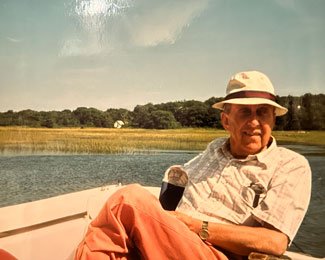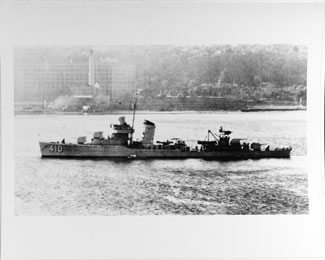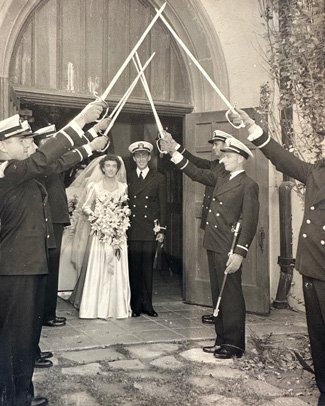No One Ever Connected the Dots of Our Boating Life and the Nightmare of My Father’s War
I wanted nothing more than to be on a boat with my dad, motoring around the dazzling blue waters off the coast of Massachusetts while he taught me how to work the gears, set an anchor, make a dock landing, and, oddly but persistently, rescue sailboats. As a Navy man, water safety was paramount, his mantra: “Always keep an eye on the weather because things can change quickly on the water.” It was an admonition freighted with the ghosts of seafaring stories.

Sally Carton’s father in the boat he used during water rescues. Photo courtesy of the author.
When we trolled for fish off the rocky shoals of our jagged coastline, I felt his love and patience. We shared a mutual contentment, whether I held the rod or crawled up to the bow to sunbathe. That bow was my seat, a triangle of a perch where, as a little girl, the orange life preserver lashed around my neck and waist, I could hold onto the center cleat while he leaned into the throttle and sent us flying across the glassy waters, sea foam exploding beneath my feet.
But then, every summer, there was always a day when everything changed. My father would spot a huge wake peeling off the stern of a much larger motorboat, and he would turn sharply into the roiling wall of water, sending the bow of our suddenly diminished boat flying up over the wave and slamming down into the trough.
I’d clench that cleat as hard as I could so as not to go flying overboard. I’d scream for him to stop, but he always missed a beat and persisted with glee, twisting and turning to catch the next wave as my feet scrabbled at the edge of the bow. After a good laugh and a few more turns, he’d stop. And as quickly as it ended, I’d join in the laughter, concealing my fear. Yes, things could change quickly on the water.
These moments of fear faded into the haze of those beautiful summer days and the joy of being in the big old barn of a house my parents rented for two months every year. Our west-facing house sat on a rocky promontory overlooking the confluence of the Annisquam River and Ipswich Bay, a large bowl-shaped bay between Cape Ann and the rest of the Massachusetts coastline. At high tide our view was of a glimmering expanse of water skirted by white sand beaches and hulking mounds of boulders that run up the coast to Maine. When the wind was right, the large swells we called “rollers” swept in from the open ocean.
My father kept a telescope on the back porch from which he could investigate any boating mishap in our purview. From this perch, he would watch for unlucky sailors whose boats ran aground on the sandbar when the outgoing 10-foot tides made navigation treacherous. He didn’t just casually point out the beached boats; he’d check on them all day, making sure they were lifted to safety on the incoming tide. But his real preoccupation was looking out for the smaller sailboats—the Fish Boats and Lightnings—competing in the bay every Saturday and Sunday in the local yacht club races. As bad weather came in or sudden gusts flipped them over, he would dash to their rescue. And of course, I dashed with him, game for an adventure with my dad.
Award-Winning Journalism in Your Inbox
Only in retrospect did I come to see that my father’s preoccupation with boats in distress was unusual, and it was a lifetime before I came to understand that everything he did on the water was shaped by what had happened to him on a destroyer in the South Pacific during World War II. It was a story that he never talked about, and no one in my family ever connected the dots between our boating life and the nightmare of my father’s war.

Diorama by Norman Bel Geddes depicting the explosion of depth charges from USS Hammann as she sank alongside USS Yorktown during the afternoon of June 6, 1942. Both ships were torpedoed by a Japanese submarine while Hammann was assisting with the salvage of Yorktown. USS Vireo (AT-144) is shown at left, coming back to pick up survivors, as destroyers head off to search for the submarine. Photo by the U.S. Navy, courtesy of the National Archives.
I came to this story—to these dots—by way of my confusion about why, growing up surrounded by sailors, I should carry such a fear of being out there on that wide blue expanse fending off the nagging sense that disaster could strike at any moment. What I didn’t know was that it had struck already and that, in these summer days, I was riding shotgun on my father’s quest to undo a moment of complete helplessness and horror during the Battle of Midway.
Both my parents grew up with boats, and, from an early age, being on the water with them was a part of my life. When I was young my mother took me out for sails in our small, tubby boat called a Turnabout. We’d head for the tidal marshes, where the incoming tide swelled and curled through alleyways of marsh heather and sea grass, the only sound the wet suck and slapping of the water against the hull.
If sailing was about tranquility for my mother, boating was about mission for my father. His first boat was an open 14-footer with a 45-horsepower motor clamped onto the transom. Two orange fuel cans sat on the floorboards supplying gas through a black rubber fuel line. Starting the motor required a strong back and an explosive pull. I can still see him, his body bent over the motor, legs braced, his left hand resting on the motor casing, his right arm yanking forcefully at the pull cord until the motor caught and sprang to life. With all the lines precisely coiled and the bumpers on board, he would load us up in this very small vessel—my mother, my friend Annie, and me—for picnic trips to a nearby beach across the bay. His eyes gleaming, one hand gripping the tiller, he turned us out of the harbor with the satisfaction and sense of possibility of a movie star Navy man.

Survivors of the U.S. Navy destroyer USS Hammann are brought ashore at Pearl Harbor from USS Benham on June 9, 1942, three days after their ship was sunk. U.S. Naval History Heritage Command photo.
We would make a beach landing and spend the day frolicking, eating sandwiches and potato chips but always—always—watching the tides, checking the boat, making sure never to be stranded by an outgoing tide. There was always that little frisson of worry. Being a magnet for parental anxiety, I always picked up the signals.
I might have been 7 or 8 when he took me on my first rescue. Most of them felt like a water sport on a summer’s day, the clear water, the taste of salt on my lips, and the capsized young sailors who all knew the drill of a sea rescue. Their life preservers up under their chins, they swam around their half-overturned hull and hauled themselves up on the protruding centerboard to lever the boat back up. The sail would spring into the air, dripping and flapping. My father would throttle down the motor and hold our boat steady next to them as they clamored back into theirs to bail out the water. The less adept skippers might need some guidance, which Dad calmly offered until they were safely situated, their bow lines attached to our stern for the slow tow back to the harbor.
But just as readily as I could enjoy the fun of it—the appreciative sailors, the satisfaction of being with a father who knew exactly what to do, the proud return to the harbor with our rescued sailors in tow—I also felt the worry of it, the possibilities. Someone trapped beneath a sail, someone pinned under a boat, and someone too cold from treading water for too long. What were we doing out there? Maybe that was the question that I finally asked on the last rescue that I can remember.
It was a regatta that involved multiple yacht clubs from around the cape. The bay was thick with boats when a squall came up suddenly. Maybe we were coming back from our beach outing, or maybe my father had seen the storm coming and we’d headed out to help. All I know is that many boats went over. We came upon a Lightning that had capsized with its spinnaker up. This enormous third sail—those brightly colored parachutes that billow out across the bow when a boat is running before the wind—was now a massive sling of water suspended beneath the boat and heavy enough to prevent it from being righted. The boat had “turtled.” And because the boat had been sailing on a run, its centerboard was not sticking out to form that small but essential fulcrum that a person could use to right it. The 19-foot hull sat like a giant, overturned bathtub, the waves sloshing over it.

USS Hughes photographed circa 1939-1940. U.S. Naval History and Heritage Command photo.
The wind was whipping up the water and the three sailors, two men and a woman, were bobbing up and down in the chop, trying to hold onto the boat as they treaded water, the fear in their eyes scaring me. Dad circled them, our boat pitching wildly as he kept working the gears to keep us off them, but close enough to be heard. The water was particularly cold that day and the air was chilly. They were cold. Three wet faces looked up from the water, asking for help. The wind was rocketing around us, snatching my father’s words away as he shouted instructions. The engine growled incessantly. Dad understood the problem and knew what had to be done. Getting close enough to talk, close enough for us to bring the female sailor on board and wrap her in a towel, he said to the men, “You have to swim under the boat, find the spinnaker halyard, and release the spinnaker.”
There was some back and forth between the two men—a father and his adult son—as they thought through how to do this. They needed to locate the right cleat and release the line that held the spinnaker in place. I don’t know how old I was, but in my mind going under that boat meant being trapped. I thought he would drown, that this plan was really dangerous. Maybe there was a pocket of air under there. Maybe the cleat he needed to reach was out of the water in that air pocket, but I pictured it all underwater, the sailor’s arm reaching into the murk, groping into a floating tangle of lines, his air running out.
The younger man’s head dropped beneath the water, his hands gripping the edge of the boat as he propelled himself further down. He disappeared. I was knotted into a ball on the seat cushion, my eyes glued to where he went under. There was a long wait. Up he came. No luck. More talk, more tries, and finally he emerged to report that he had released the sail.
In retrospect, everything went exactly as it should have. With my father’s patient, calm guidance, they did it. They understood and were competent enough to execute the task, to find that halyard and release that weight.
Our Journalism Depends on Your Support
Another dive was made to uncleat more lines and release the centerboard. The men were then able to swim around and haul that heavy wooden boat back up by following all the usual steps. But there was nothing usual about this to me. Prior rescues came with laughter, a few jokes about the skipper’s folly, but this time there was a different soundtrack playing. The sky was dark, the wind fierce. Everything was in high relief: the thrashing of the boats, the strain to communicate over the roar of the engine, even the violent, wind-whipped beating of the slicker on my father’s back as he leaned over the throttle, holding the boat back from the men.
The scene haunted me.

Sally Carton’s parents on their wedding day, just before her father sailed toward Pearl Harbor. Photo courtesy of the author.
This rescue story lived in our family for many years. Like every adventure on the water, it made a great story, but the dots remained unconnected. After my father died, Mom started talking more about their lives during World War II. Her stories played like scenes from those old black-and-white war movies that we watched all the time: their dash to San Francisco to get married before Dad sailed toward Pearl Harbor, the shot of them at their wedding, Dad in his pristine naval uniform cutting the cake with his sword as his young wife beams. The glamorous picture of the two of them on V-J Day in the officer’s club, leaning toward each other over a white tablecloth. Glassware, drinks, celebration.
In these images my mother is elegant, a gardenia corsage on the shoulder of her tailored, knit dress, a cigarette between her painted nails. She is smiling. My father, in uniform, thin and handsome, apparently scarred only with the familiar dark circles under his eyes, looked quietly happy. Like the censored letters my mother would receive from him during the war, the reality of what he experienced had been expunged from view.
This War Horse reflection was written by Sally Carton, edited by Kristin Davis, fact-checked by Jess Rohan, and copy-edited by Mitchell Hansen-Dewar. Abbie Bennett wrote the headlines.
Part II Coming Thursday.





Comments are closed.